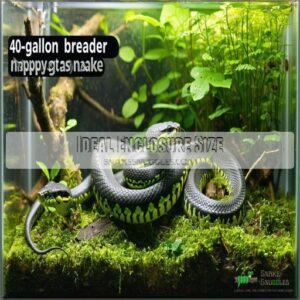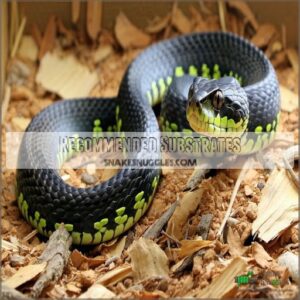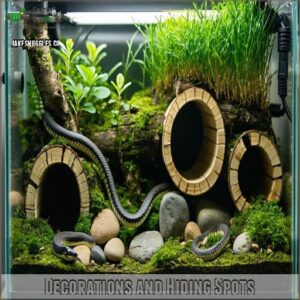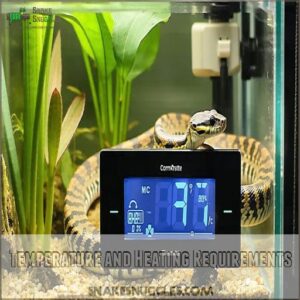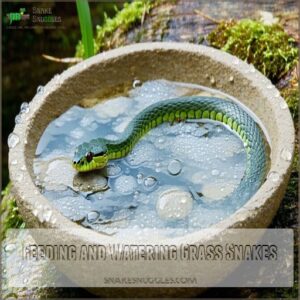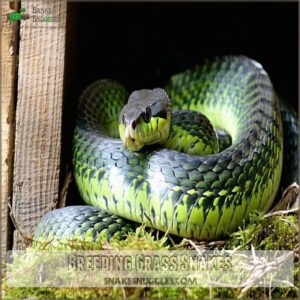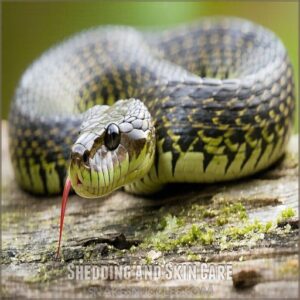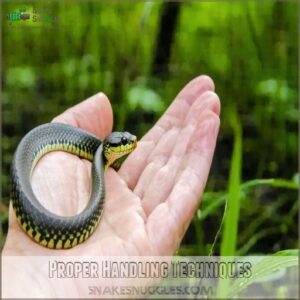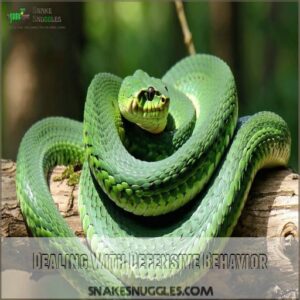This site is supported by our readers. We may earn a commission, at no cost to you, if you purchase through links.
 When it comes to grass snake care, think cozy yet wild.
When it comes to grass snake care, think cozy yet wild.
Picture a 40-gallon tank with snug substrates like orchid bark or coconut husk, offering secretive spots with rocks and logs.
Keep the temperature just right—a balmy 70-80°F, topped off with a warm basking area.
UVB lighting? Absolutely! It’s like a tanning spa for their scales.
Feed them thawed mice weekly, and keep a clean water bowl handy.
Gentle handling helps them stay calm—as calm as a snake can be, that is.
Fancy being the snake whisperer? Explore more tips in the full guide, where mastery awaits!
Table Of Contents
- Key Takeaways
- Grass Snake Care
- Natural History of Grass Snakes
- Housing and Enclosure for Grass Snakes
- Temperature and Heating Requirements
- Lighting and UVB Requirements
- Feeding and Watering Grass Snakes
- Breeding Grass Snakes
- Shedding and Skin Care
- Handling and Behavior of Grass Snakes
- Common Health Issues and Care Tips
- Frequently Asked Questions (FAQs)
- Conclusion
Key Takeaways
- Set up a cozy 40-gallon tank with substrates like orchid bark or coconut husk and include hiding spots to maintain a 50-70% humidity level.
- Maintain a temperature gradient of 70-80°F, with a basking spot around 80°F, using basking lamps and thermostats for a comfortable environment.
- Provide UVB lighting to enhance calcium absorption and overall health, which supports digestion, bone health, and easier shedding.
- Feed thawed mice weekly and keep a clean water bowl accessible to ensure proper hydration and nutrition.
Grass Snake Care

Creating the perfect grass snake habitat is all about balance and comfort.
To achieve this, consider using a 40-gallon tank with dimensions of 36”x18”x12” for an optimal enclosure size.
Start with a cozy enclosure using substrates like orchid bark or coconut husk to maintain the 50-70% humidity level they love.
Handle them with care, using hooks or tongs to avoid their lovely but bristly teeth, which can nip if they get spooked—think of it as their version of a handshake.
Regarding feeding, opt for thawed mice, perfect for your snake to gobble up every 7-14 days.
Plus, planning a grass snake enclosure with a hint of humor and love is key—after all, you’re creating a miniature snake paradise where your scaly friend can thrive delightfully!
Natural History of Grass Snakes
Understanding the life of a grass snake is like delving into a tale of survival and adaptation.
These slinky Natrix natrix beauties sport a chic white or yellow band around their necks and can grow up to five feet long.
Typically seen near European ponds during frog spawning seasons, they thrive on a diet of amphibians and small rodents, much like their popularity as pets, which is attributed to their gentle temperament and semi-aquatic nature, making them an appealing alternative pet.
Their predators include birds of prey and mammals, making camouflage their best friend.
In the wild, grass snakes hibernate to escape the winter chill.
When caring for a grass snake, mimicking these natural habitats and dietary needs is essential.
With the right balance, these snakes can live happily, charming any reptile enthusiast.
Housing and Enclosure for Grass Snakes
When setting up a home for your grass snake, you’ll want to make it both cozy and secure, giving your slithery friend plenty of room to stretch out.
Think of it as a real-life activity center, complete with thoughtful substrates and sneaky hiding spots to keep your pet happy and thriving.
Ideal Enclosure Size
Generally, a 40-gallon breeder tank (36”x18”x12”) offers ample space for a grass snake.
This minimum tank size allows for comfortable movement and space for growth.
Make sure there’s adequate ventilation to prevent escapes.
Remember, proper tank dimensions are important for a happy snake!
Consider terrarium volume when choosing an enclosure.
Providing a temperature gradient is key for their well-being.
Recommended Substrates
Choosing the right substrate for your grass snake can feel like picking the perfect pair of shoes—it just has to fit right.
Options like orchid bark, coconut husk, and cypress mulch are spot on.
They keep moisture in check, creating a comfy environment.
Plus, these natural alternatives make cleaning a breeze, ensuring your snake feels at home.
Decorations and Hiding Spots
A grass snake’s terrarium is its home base, so make it comfy!
Use natural materials like stones and logs for hiding spots.
DIY options like PVC pipes add extra enrichment.
Keep safety first—smooth surfaces prevent injury.
Hiding spots reduce stress, making your snake feel like royalty in its domain.
Remember, a safe and enriched habitat leads to happy snakes!
Temperature and Heating Requirements
Keeping your grass snake comfortable means setting the right temperature in its enclosure, like having just the right blanket on a chilly night.
You’ll need to manage basking lamps and thermostats to create a cozy environment, ensuring your scaly friend feels right at home.
Ideal Temperature Range
Creating the right temperature gradient in your grass snake’s enclosure is key.
Aim for an ambient range of 70°F to 80°F, with a basking spot hitting 80°F.
A heat mat can help set this up.
To make sure your snake’s comfy, include two hides, keep the cool end around 70°F, and add natural elements like plants and logs.
Basking Lamps and Thermostats
To keep your grass snake happy and healthy, basking lamps and thermostats are key players.
Here’s how you can achieve mastery in grass snake care:
- Choose the right basking lamp for even temperature.
- Calibrate thermostats to keep things in check.
- Position heat lamps safely and securely.
Keep these tips in mind for a happy, healthy snake!
Nighttime Heating
Temperature management at night for your grass snake involves a little strategy.
Use heat mats on the cooler side of the terrarium with thermostat settings for ideal temperatures.
Maintain nighttime humidity at 50-70% to support shedding.
Keep energy efficiency in mind while setting up your reptile’s space, making sure it’s both cozy and cost-effective.
Lighting and UVB Requirements
While grass snakes don’t need bright lights like some other reptiles, providing UVB lighting offers significant health benefits, boosting their calcium absorption and overall well-being.
We’ll explore the types of UVB tubes best suited for your slithery friend, ensuring they thrive under the perfect "sun.
Benefits of UVB Lighting
Imagine your grass snake basking under its own mini sun! UVB lighting in their terrarium isn’t just a fancy light show. It helps with vitamin D production, which means better calcium absorption and healthy bones. This lighting setup keeps your snake’s skin healthy too, preventing eye issues and metabolic bone disease. You can even find a suitable UVB lamp for your snake by checking out some options at UVB lamps for snakes.
Here’s why they’ll love it:
- Supports digestion and bone health
- Aids in easier shedding
- Mimics natural sunlight
- Enhances reptile health
Recommended UVB Tube Types
Choosing the right UVB tube for grass snake care can make a world of difference.
Opt for a 5% T8 or 2-5% T5 UVB tube, placed 6-12 inches above your snake’s home.
This setup keeps your little buddy basking comfortably.
| Brand | Wattage | Lifespan | Placement | Maintenance |
|---|---|---|---|---|
| Arcadia | 24W | 6-12 months | 6-12 inches | Monthly checks |
| Zoo Med | 20W | 6 months | 8-10 inches | Replace biannually |
| Exo Terra | 25W | 8 months | 10 inches | Clean quarterly |
| ReptiSun | 22W | 10 months | 8-12 inches | Inspect frequently |
| SunBlaster | 18W | 6-9 months | 6-10 inches | Change yearly |
For reptile care, proper UVB tube maintenance guarantees a cozy terrarium.
Feeding and Watering Grass Snakes
Feeding your grass snake involves serving an appropriately sized carnivorous diet, mainly consisting of small rodents, on a regular schedule to keep them healthy and active.
Don’t forget to always provide clean, fresh water in a shallow bowl, because even snakes need to hydrate to avoid being hiss-terically grumpy!
Carnivorous Diet
A grass snake’s dietary needs can be a bit like your snacks—varied and nutritious.
Grass snakes relish a carnivorous menu of live frogs, fish, and insects.
Captive-bred snakes might prefer frozen-thawed mice.
Feeding live prey can stimulate their natural hunting instincts and boost their immune system through live prey feeding benefits.
Keep it interesting with:
- Protein Variety: Different prey types provide balance.
- Feeding Frequency: Adjust for age and activity.
- Food Storage: Safely store frozen options for convenience.
Feeding Schedule and Prey Size
Feeding your grass snake can’t be left to chance.
Offer prey sizes that match their growth stages, feeding more frequently when they’re young.
You’ll want to keep an eye on feeding frequency to avoid overfeeding risks while supporting nutritional needs.
Here’s a handy chart to keep track:
| Snake Age | Feeding Frequency | Prey Size | Snack Ideas | Risks |
|---|---|---|---|---|
| Baby | 3-7 days | Small | Pinkies | Overfeeding |
| Juvenile | 5-10 days | Medium | Fuzzies | Obesity |
| Adult | 7-14 days | Large | Mice | Malnutrition |
| Senior | 10-14 days | Varied | Small Rats | Health Issues |
| Elderly | 14 days | Varied | Small Mice | Underfeeding |
Always stick to prey smaller than their head width to prevent injury.
Providing a Water Bowl
Because hydration’s key, provide a spacious water bowl—think, a good-sized dish, not a thimbleful!
You can find the perfect water bowl for your pet at online stores that sell grass snake water bowls.
Secure it to prevent spills.
Clean it regularly; dirty water breeds disease.
Use filtered water if possible.
This simple step keeps your grass snake happy and healthy.
Breeding Grass Snakes
If you’re thinking about breeding grass snakes, you’ll need to understand their natural mating habits and how to set up a cozy nesting box.
Don’t worry, it’s not as complex as it sounds—just make sure the eggs get the right incubation conditions, and you’re on your way to becoming a successful snake parent!
Natural Mating and Nesting
Ever wondered how grass snakes get in the mood for love? As spring breathes life into nature, the mating season kicks off.
These snakes choose cozy nest sites, laying eggs that require a careful touch during their 60-day incubation. Ensuring the right temperature and humidity is akin to creating a perfect storm for successful hatchling care and growth.
| Key Aspect | Description | Tip |
|---|---|---|
| Mating Season | Occurs in spring | Monitor behavior for signs |
| Nest Site Selection | Quiet, humid areas preferred | Mimic natural conditions in captivity |
| Incubation Period | Lasts about 60 days | Keep humidity consistent with a hygrometer |
Creating a Nesting Box
Building a nesting box for your grass snakes is like setting up a cozy maternity ward.
To make sure mating and fertilization are successful, it’s important to provide a suitable environment that mimics natural seasonal cycles, including proper temperature, humidity levels, and hiding spots, as explained in the guide on how to breed snakes.
Use materials like soil or peat moss, and keep an incubation temperature between 84°F and 88°F.
Place the box in a quiet spot of the terrarium, ensuring good ventilation and easy access for monitoring.
Patience is key, as proper setup leads to healthy hatchlings.
Incubation Guidelines
Maintaining the right setup for incubating grass snake eggs is like preparing the perfect home for new arrivals.
Aim for an incubation temperature of 84°F with consistent humidity control. Daily checks make sure everything’s on track.
Remember these tips:
- Make sure you have proper humidity.
- Monitor temperature regularly.
- Keep the setup clean.
- Avoid handling eggs directly.
- Be patient during the 60-day incubation period.
Shedding and Skin Care
Shedding is a natural process for your grass snake, but keeping humidity levels just right is key to a smooth change.
Provide plenty of surfaces for rubbing, helping your slithery friend slip out of their old skin like it’s a snug sweater.
Maintaining Humidity Levels
Humidity plays a big role in grass snake care, especially during shedding. Keep it between 50-70% using a hygrometer. Choose snakey-safe plants to boost humidity, and provide a bath now and then in a large water bowl.
Captive-bred snakes are easier to manage compared to their wild counterparts, making humidity control manageable.
| Humidity Level | Action | Tools Required |
|---|---|---|
| Low | Increase misting | Spray bottle |
| High | Improve ventilation | Hygrometer, fan |
| Ideal | Maintain setup | Regular checks |
| Dry Shedding | Provide bath | Large water bowl |
| Consistent | Check hygrometer | Digital hygrometer |
Adding Rubbing Surfaces
So, you’ve got the humidity just right for your grass snake’s shedding. Great! Now, let’s talk about helping that process along.
Adding some rough surfaces to its enclosure is key.
Consider browsing online for a suitable branch for snake enclosure, which can be found on websites like branch for snake enclosure. Think branches, cork bark, or even some strategically placed rocks.
These give your snake something to rub against as it sheds, making the whole process smoother and less stressful. It’s like giving them a spa day for their skin! Remember, a happy snake is a healthy snake.
Assisting With Shedding Process
Shedding for your grass snake can feel like a dry spell.
You can make it smoother by adding rough surfaces like natural rocks or logs.
Keep a comfortable temperature gradient—80°F basking, 70°F on the cool side—with a UVB tube for light.
Sprinkle in humidity boosts like water soaking to help shed effortlessly.
Keep their diet in check and enjoy watching them thrive!
Handling and Behavior of Grass Snakes
Handling grass snakes involves gentle, consistent practice to build trust and reduce stress.
Don’t worry if your snake initially emits a smelly musk; it’s their way of saying, "Hey, let’s get acquainted slowly!
Proper Handling Techniques
Handling your grass snake should feel like guiding a gentle ribbon through your hands.
Keep it stress-free by moving slowly and confidently, respecting their boundaries.
Use tools like hooks for added safety, and always start with a secure environment.
Consult with a vet if needed.
After handling, gently return them to their enclosure for safe keeping.
Dealing With Defensive Behavior
Facing a grass snake’s defensive behavior can be like dealing with a prickly friend on a bad day. They might bite, but don’t sweat it—practice makes perfect.
Here are three tips:
- Observe closely to spot stress signs.
- Use gentle handling techniques, like hooks and tongs.
- Clean bites thoroughly with soap and water, applying antibacterial cream as needed.
Musking and Its Causes
Musking is a snake’s way of saying, "Back off!" It happens when stress levels rise, often during handling. Watch their moves—tail twitching means discomfort.
Make sure the prey size is right, and keep the enclosure snug. If the smell sticks around, a vet visit might be in order.
Here’s a quick breakdown to help you out:
| Trigger | Cause |
|---|---|
| Sudden Movements | Stress |
| Handling | Discomfort |
| Improper Prey Size | Nutritional Imbalance |
| Inadequate Enclosure | Environmental Stress |
Remember, a musk-free snake is a happy one!
Common Health Issues and Care Tips
Keeping your grass snake healthy involves looking out for signs of illness and ensuring their home is clean as a whistle.
If your snake seems a bit off, don’t hesitate to schedule a vet visit—after all, even scaly friends deserve excellent healthcare!
Signs of Illness in Grass Snakes
So, you’ve bonded with your grass snake, but how do you know if it’s feeling under the weather?
Weight loss? No appetite? Lethargy? These are red flags.
Is it shedding oddly? Eye problems? Respiratory distress? These aren’t normal.
A healthy snake is active and eats well. Notice any changes? It’s time to observe closely.
Early detection is key for your scaly friend’s well-being.
Regular Cleaning and Disinfection
Keeping your grass snake’s home clean is a lot like cleaning your own kitchen.
Spot clean daily to remove feces and urates, using tongs to avoid direct contact, as discussed in snake cage cleaning best practices Snake Tank Maintenance.
Give a full scrub every four weeks.
Use reptile-friendly products for your terrarium setup.
Clean water bowls weekly to dodge parasites and fungus.
With these snake care tips, you’ll have excellent hygiene practices and bacterial control.
Seeking Veterinary Care
Taking your grass snake to the vet isn’t just for emergencies—it’s important for preventive care.
Regular check-ups can catch issues early, like parasites or common diseases.
Here’s how to prepare:
- Gather previous vet records and dietary details.
- List any questions about possible treatments.
- Choose a vet experienced with reptiles to make sure they provide expert care.
Frequently Asked Questions (FAQs)
How to care for a snake plant?
Think of a snake plant as a low-maintenance roommate.
Give it bright, indirect light, water sparingly when dry, and provide well-draining soil.
Fertilize every few months, and watch out for pests like mealybugs.
How do you get rid of a snake plant?
To get rid of a snake plant, you can give it to a friend, sell it online, or donate it.
Alternatively, compost it safely by removing the plant from the pot and placing it in your compost bin.
How often do snake plants need to be watered?
Water your snake plant when the top inch of soil feels dry.
That’s usually every 2-3 weeks in spring and summer, less often in winter.
Don’t let it sit in water!
How do you feed a snake plant?
Feeding a snake plant starts with giving it the right nutrients, like a balanced liquid fertilizer.
Pour it onto the soil every few months during growth.
Just enough food to keep it healthy and thriving!
Why should I put a snake plant in my house?
Snake plants boost your home’s air quality by filtering pollutants and releasing oxygen at night.
They’re low-maintenance, thrive in various light conditions, and add a stylish touch to decor, making them perfect for busy plant lovers.
Conclusion
Mastering grass snake care isn’t a tall order.
With the right blend of cozy habitats, a diet of thawed mice, and a spa-like touch with UVB lighting, you’ll keep your slithery friend in tip-top shape.
Handle them gently, just like folding your favorite sweater, and watch for signs of discomfort or illness.
Embrace the journey of becoming a snake whisperer; it’s all about patience and learning.
Your snake will thank you with a flick of its tongue.


